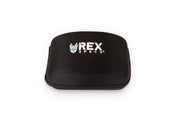It's not uncommon for German Shepherds to experience "Pannus" in their lives. This painful inflammatory disease is caused by a malfunction of the immune system and cannot yet be cured. You can find more information in our blog post : " A Comprehensive Guide to Pannus (German Shepherd Keratitis) in Dogs."
Contents:
- What is Pannus?
- How does Pannus manifest itself?
- How does Pannus develop?
- What are the consequences of Pannus?
- How does the veterinarian treat Pannus?
- What can the dog owner do?
- Active prevention with dog goggles
What is Pannus?
German Shepherd Keratitis (keratitis superficialis vasulosa pannosa pigmentosa chronica) is a chronic, superficial inflammation of the cornea and, usually, of the conjunctiva of the eye . In veterinary medicine, it is also known as "Überreiter's keratitis" after its first describer.
The name German Shepherd Keratitis is derived from the fact that this disease occurs primarily in German Shepherds and only very rarely in other dog breeds (Collie, Poodle, Dachshund, Greyhound, mixed breed).
"I have a Belgian Shepherd. He is now 7 years old. About 8 months ago I noticed a redness in the outer corner of his eyes. Now this redness is much more pronounced, with capillaries forming a visible network and the sclerosis (?) in the area of the iris turning white."
How does Pannus manifest itself?
The disease, which usually breaks out between the dog's 3rd and 5th year of life, almost always begins simultaneously in the outer parts of the cornea of both eyes . At the border between the white part of the eye and the cornea, which is usually heavily pigmented, vascular granulation and connective tissue grow into the upper layers of the cornea, which becomes visible in the formation of an opaque, superficially uneven, cherry-red colored spot. This spot is usually bordered by a greasy, gray-white border.
As the disease progresses, pigment-producing cells migrate from the peripheral areas into the altered area, giving the spot, which expands towards the center of the cornea, a more gray-pink to spotty brown-black marbled appearance.
At the same time, there is often redness of the conjunctiva due to inflammation.
Without treatment, the inflammatory process often progresses and eventually spreads across the entire cornea, which can lead to the dog becoming completely blind .
How does Pannus develop?
Although infectious agents were previously discussed as a cause of German Shepherd Keratitis, today it is generally believed, although the exact causes of the disease are still not known in detail, that the disease is caused by a malfunction of the immune system, in which the organism produces antibodies or cell-toxic immune cells against the body's own tissue in the sense of an autoimmune disease.
Other factors, both the body's own (=endogenous) and those affecting it from outside (=exogenous), are also involved in the outbreak of the disease.
An endogenous factor in this context seems to be a breed-related hereditary predisposition of the German Shepherd Dog to this disease, the inheritance of which is not yet known.
Among the exogenous factors, the ultraviolet radiation component of sunlight is considered to be of outstanding importance as a trigger for German Shepherd keratitis, which explains the frequent outbreak of the disease in the sunny months.
What are the consequences of Pannus?
If the dog is not treated by a veterinarian, the disease often progresses in phases, which, due to the symptoms described above, can lead to corneal blindness in the final stages of the disease, as the cornea loses its transparency, which is necessary for vision, due to the pigment deposition.
Since German Shepherd Keratitis generally occurs bilaterally, complete loss of vision is to be expected sooner or later.
How does the veterinarian treat Pannus?
Since a cure for the disease in the true sense of the word is not possible according to the current state of science, the aim of treatment can only be to bring acute attacks under control as quickly as possible, to prevent further outbreaks of the disease, and thus to keep the described consequences of the disease as low as possible.
As mentioned above, German Shepherd keratitis is caused by a "misreaction" of the body's immune system, and can be suppressed by local cortisone injections. In the acute stage of the disease, the veterinarian administers injections under the conjunctiva of the affected eye. Before this treatment, the eye is numbed superficially by instilling a local anesthetic so that the injection is not painful for the dog. At home, the owner of the animal continues the cortisone therapy in the form of an ointment treatment, which must initially be administered several times a day (4-5 times), and then gradually reduced depending on the veterinary check-ups, but must be maintained at a low maintenance dose for the entire life of the dog (1 time a day).
In hopelessly neglected cases, or in cases where the disease cannot be controlled with medication and has led to the animal going blind, it is still possible to surgically remove the affected upper layers of the cornea. However, since this relatively serious procedure cannot be repeated as often as desired and the disease is not cured by it, this method should only be reserved as a last resort for very advanced cases.
What can the dog owner do?
In addition to the consistent implementation of the long-term therapy prescribed by the veterinarian , the regular re-presentation of the dog for check-ups in the clinic or practice of the treating veterinarian, the immediate (!) consultation of the veterinarian in the event of a recurrence of acute symptoms of the disease, all factors that cause the outbreak of the disease should be kept away from the patient.
Since the short-wave radiation component of sunlight has been shown to play a major role in the occurrence of acute attacks of the disease, the eyes of the affected dogs should be protected from excessive UV radiation (bright sunshine with a cloudless sky, sunshine in snow-covered landscapes, especially at high altitudes, sunshine when staying near or on bodies of water). This means that on days when increased UV radiation is to be expected, the dogs should only be taken for long walks in the early morning hours, in the evening or in the forest, and otherwise should be kept indoors or in places without direct sunlight, i.e. in the shade, during the day.
If UV exposure of the dog cannot be avoided for various reasons, the animal's eyes must be protected when it is in a sunny environment. This can be achieved either by wearing special dog goggles , which many dogs tolerate without any problems after a short period of getting used to them , or by instilling a substance that protects against UV rays into the conjunctival sac of the eye. The effectiveness of the latter measure is only of a relatively short duration, so the medication must be repeated at certain intervals (approximately every hour).
Author: Veterinarian Dr. Willy Neumann Published on www.tiermedizin.com
Many thanks to Dr. Neumann for kind permission to publish
Active prevention with dog goggles
In our shop, you'll find Rex Specs dog goggles, developed in the USA for service dogs and ready for any adventure. With these protective goggles for dogs, you can enjoy outdoor activities in bright sunshine with a clear conscience. Carat Dog Accessories is the exclusive retailer for these high-quality dog goggles in Germany.
Why Rex Specs dog glasses? 8 convincing advantages click here




